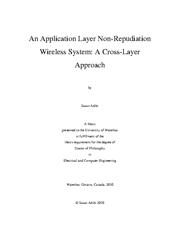A copy of this work was available on the public web and has been preserved in the Wayback Machine. The capture dates from 2017; you can also visit the original URL.
The file type is application/pdf.
An application layer non-repudiation wireless system: A cross-layer approach
2010
2010 IEEE International Symposium on "A World of Wireless, Mobile and Multimedia Networks" (WoWMoM)
Non-repudiation techniques are to ensure any communication taking place between two or more parties will be undeniable. Therefore it is crucial to include digital signatures of the involving parties while the communication is taking place. In medical practices, involved parties include; patient(s), doctor(s), pharmacist(s), who are involved in series of visits, diagnosis, prescriptions, and possible operations. To avoid possible conflicts, deploying non-repudiation techniques help immensely.
doi:10.1109/wowmom.2010.5534971
dblp:conf/wowmom/Adibi10
fatcat:tzhws7t5tzao7eh7qcxfn5srfy

